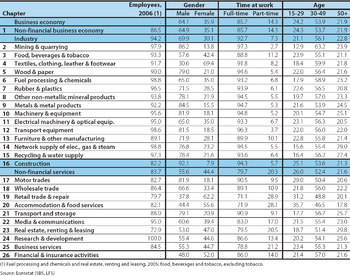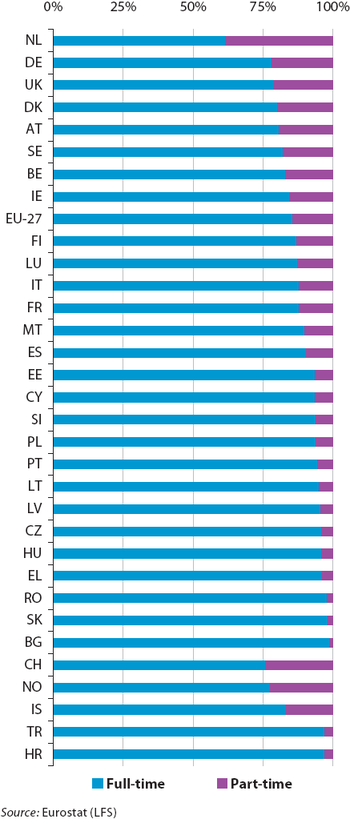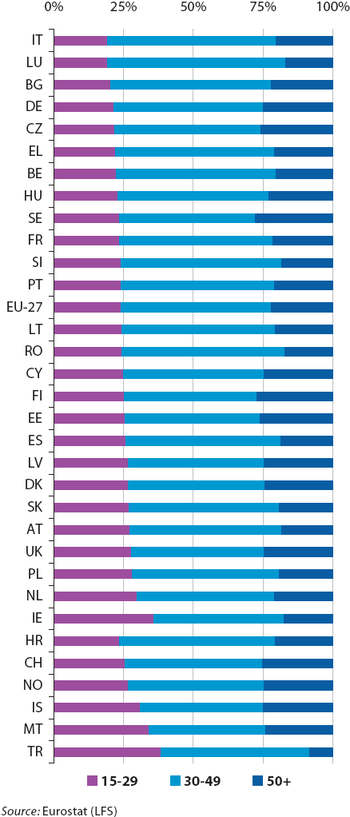Archive:Business economy - employment characteristics
- Data from January 2009, most recent data: Further Eurostat information, Main tables and Database
This article belongs to a set of statistical articles which analyse the structure, development and characteristics of the various economic activities in the European Union (EU).
The present article is part of the business economy overview, and covers employment characteristics of the business economy.
Main statistical findings
The EU-27's labour force is characterised by considerable differences in terms of its gender profile (see Table 1). Across the whole of the business economy (NACE Sections C to K, and therefore including financial and insurance services), almost two thirds (64.1 %) of those employed in the EU-27 in 2007 were male. The imbalance between the sexes was most evident in the construction sector, where men outnumbered women by a ratio of more than nine to one (92.1 %), while 69.9 % of the industrial workforce was male, and 55.6 % of those working in non-financial services were men. All but one of the industrial sectoral aggregates that are used as structural business statistics article headings reported a majority of their respective workforce was composed of men, the exception being the textile, clothing, leather and footwear manufacturing sector where women represented 69.4 % of those employed. Among the articles that cover the services economy, women outnumbered men in three activities, namely: retail trade and repair; accommodation and food services; and financial and insurance services.
Some 14.3 % of those persons employed within the EU-27's business economy in 2007 worked on a part-time basis. The rate of part-time employment across industrial activities (7.3 %) was about half the business economy average, and this rate fell further still to 5.7 % for the construction sector, while part-time employment accounted for in excess of one in five persons (20.3 %) within non-financial services. At a more detailed level (the structural business statistics article headings) there was a clear link between those activities with relatively high levels of part-time employment and those with relatively high female employment rates. Upwards of one in five persons worked on a part-time basis within retail trade and repair, accommodation and food services, and business services, as well as in the real estate, renting and leasing sector.
The age profile of employment across Member States reflects, to some degree, demographic trends such as ageing populations and baby-boom cohorts, as well as opportunities to remain within higher education, the average length of higher education courses, and the availability of work and job placements. At the other end of the age range, the proportion of older workers may be influenced, among other factors, by pension rights, age-related wage schemes, and the availability of lifelong learning programmes. Within the EU-27's business economy almost one quarter (24.2 %) of the total workforce were aged between 15 and 29 years old, slightly more than half (53.9 %) were aged 30 to 49, and the remaining 21.9 % were aged 50 or more. The age profile was relatively stable across the three main activity aggregates of industry (56.1 % of the workforce were aged 30 to 49), construction (53.6 %), and non-financial services (52.4 %). Those differences that did exist largely reflected education/skills levels and/or experience requirements of particular sectors. For example, accommodation and food services (35.7 %) and retail trade and repair (31.2 %) reported relatively high proportions of young workers. In contrast, there were relatively few young workers employed within mining and quarrying (12.9 %), perhaps reflecting that this is a declining industry where there is less of a need to engage new staff.
Employment characteristics tend to be relatively similar across the activities within a particular country, which may be explained by structural factors. For example, the proportion of women working was high (40 % or above) in the business economies of the Baltic Member States, Bulgaria and Romania, whereas it was generally low in the Mediterranean Member States – in particular, Italy, Greece and Malta (see Figure 1). This pattern was often repeated at different levels of activity breakdown. Indeed, the likelihood that a woman works probably reflects, to some degree, socio-economic policies regarding family allowances, the availability of crèches and after school care, part-time employment opportunities, as well as cultural differences with respect to the interdependence and/or independence of (extended) family units.
The Netherlands stood out as having by far the highest part-time employment rate for the whole of the business economy in 2007 (38.4 %), while more than one in five persons in Germany and the United Kingdom also worked on a part-time basis. This contrasted vividly with the situation in Slovakia and Bulgaria, where no more than 1 in 50 persons worked on a part-time basis (see Figure 2). None of the Member States that joined the EU in 2004 or 2007 reported a particularly high rate of part-time employment; the highest being Malta (10.1 %), below the EU-27 average.
According to SBS data, across the EU-27's non-financial business economy the average share of paid employees in the total number of persons employed was 86.5 % in 2006. This share was generally highest within industrial activities (94.2 %), falling to 83.7 % for non-financial services. The activities where employees accounted for the smallest share of total employment in 2006 (in other words, where there was the highest proportion of working proprietors and unpaid family workers) included real estate, renting and leasing (72.9 % of those employed in 2005 were employees), retail trade and repair (79.7 %), accommodation and food services (82.1 %) and construction (82.2 %) – all of which are characterised by a high proportion of small, often family-run enterprises.
Data sources and availability
The information that is presented within this section is largely derived from the Labour Force Survey (LFS) which collects information from individual households (rather than from enterprises). Note that the data pertain to an annual average for each reference year, which marks a change from previous presentations of the statistics where LFS data has generally been presented in relation to the second quarter of a particular reference year.
Other data sources include structural business statistics (SBS), including core, business statistics which are disseminated regularly, as well as information compiled on a multi-yearly basis, and the latest results from development projects.
Context
Article 39 of the EC Treaty lays down a fundamental freedom that entitles persons from within the EU to look for a job, work, and at the same time live, in any other EU country, while enjoying equal treatment in terms of access to employment, working conditions and all other social and tax regimes.



